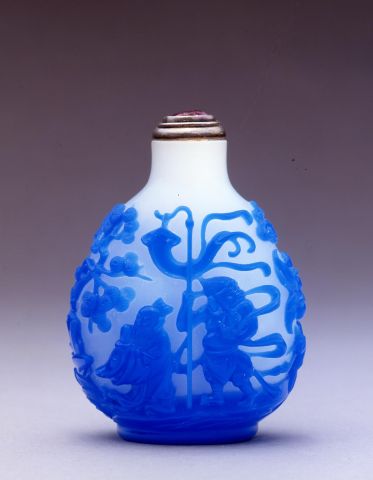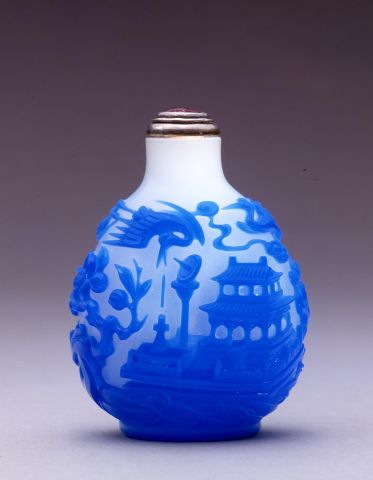

Bottle ID: 00314
WHITE W/BLUE OVERLAY, MYTHOLOGICAL SCENE
Date: 1736-1799
Height: 59 mm
Glass, of flattened pear shape with sloping shoulders, carved in varying relief in opaque sapphire-blue on a cloudy white ground, with a continuous mythological scene in which a scholar, holding a hu ('audience tablet'), and standing beside a rocky outcrop with a pine tree, is attended by a demon holding a ribboned banner, standing beside a peach tree, and lingzhi; the reverse with a scene of formalized waves from which a heavenly palace arises with two cranes flying above in the scrolling clouds, one dropping an arrow into an arrow vase set on the terrace of the palace next to an astrological instrument.
Possibly Imperial, attributed to the Palace Workshops, Beijing.
Similar Examples:
Lawrence, Clare. Miniature Masterpieces from the Middle Kingdom - The Monimar Collection of Chinese Snuff Bottles, 1996, pp. 254-255, no. 121.96.
Moss, Hugh, Victor Graham and Ka Bo Tsang. A Treasury of Chinese Snuff Bottles - The Mary and George Bloch Collection, 2002, p. 521, no. 921.
Hall, Robert. Chinese Snuff Bottles IV, 1991, p. 102, no. 101.
Provenance:
Hugh Moss [HK] Ltd.
Alex S. Cussons
Exhibited:
Annual Convention ICSBS Toronto, October 2007
Apart from the unusual color of the blue overlay, this is one of the most spectacular glass snuff bottles known, with extraordinary quality of carving and fluidity of sculpture, linked to a rare subject. Generally this group of extensively carved, high quality overlays is of a deeper blue color or an intense dark red color. This bottle also raises the long-standing question of what the crane is holding in its beak when seen with the Goddess of the West, Xiwangmu. The object has often been described as a scroll, a rod or a tally. Here its identity is beyond doubt as it is one of the long straight arrows, used in the deeply ritualistic game of taohu, where arrows are thrown into an arrow-vase (a bronze vase which evolved with additional rings attached to its neck to give multiple targets). It may, of course, be that the artist who carved this particular bottle was making a unique visual pun by identifying the bird's 'rod' with the arrow-vase game. Among the high level palace artists, such a flight of the imagination may have been likely. The Monimar example cited above has a very similar subject matter with the crane flying above the heavenly palace with what the present author described as a scroll in its beak, and not an arrow vase in sight!
The Daoist goddess, Xiwangmu, presided over the Western Paradise, or heavenly palace, where the annual feast of the Immortals was held. The feast culminated in the eating of peaches from the tree of immortality.

 English
English 中文
中文